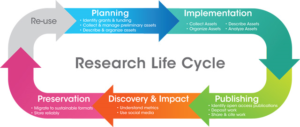by Megan Kennedy
Leslie and Irene Dubé Health Sciences Library
University of Saskatchewan
I have an idea to do some research about research. More specifically, I want to look into the research preparedness of newly graduated librarians working in an academic setting. Being that I am a librarian fairly new to the profession, I find myself thinking about this more and more and I have one big question that keeps coming to mind, “why wasn’t I better prepared”? I knew a lot of about research but not really how to do it.
My current research plan is to survey Canadian library schools’ curricular course offerings looking for mentions of “research”. I will look at the course descriptions and most recent syllabi (where available) for all courses available at the eight MLIS graduate schools in Canada and look for references to “research” and for research-focused courses. I will also look for courses focused on academic librarianship and analyze the course descriptions and syllabi for references to research.
Research is a funny thing and requires a lot of learning; you can learn methods, learn to search for and evaluate information, learn to write for other professionals, learn to collaborate with peers near and far, learn where to publish for the most impact, learn how to take criticism and accept rejection, and so much more. What I find most interesting about research, at least research for academic librarians, is that a great deal of this learning seems to take place outside of the formal MLIS program.
Research is a hugely important part of an academic librarian’s career and yet new librarians can often find themselves struggling to get things going. There are several reasons for this1 but you could see how the excess of learning throws them for a loop. Learning how to work effectively in academia is a whole thing in and of itself, and research can be the straw that breaks the camel’s back. So what is the solution? That I do not know, but I am looking into it.
We learn so much in our short time at library school but research – the nitty gritty of actually doing it – seems like it is often missed in the formal curriculum. The findings of this survey aim to highlight some of the gaps in the current curricula of Canadian library schools and suggest ways in which these gaps can exacerbate feelings of impostor syndrome for newly graduated academic librarians entering the workplace. As well, awareness of some of the gaps can help professional organizations and institutions provide valuable continuing education opportunities for new career librarians. In loftier aims, it is my hope that this research might eventually help to augment the current MLIS curricula to offer courses specific to academic research.
1Maybe one the biggest issues is that new career academic librarians are often hired into term positions that do not require, nor make time for, research as part of their duties – but that is a whole other rant for another time.
This article gives the views of the author and not necessarily the views the Centre for Evidence Based Library and Information Practice or the University Library, University of Saskatchewan.




